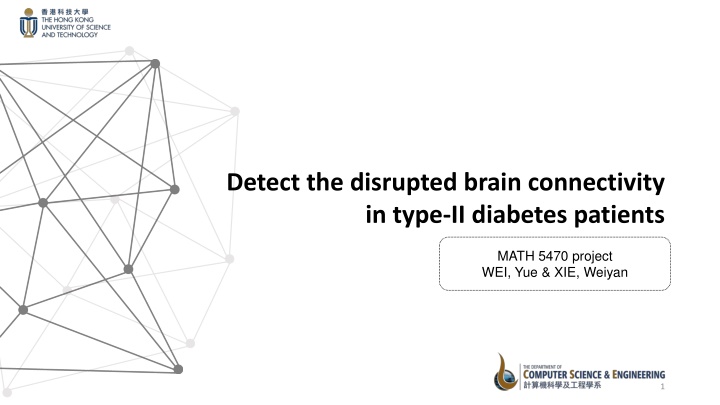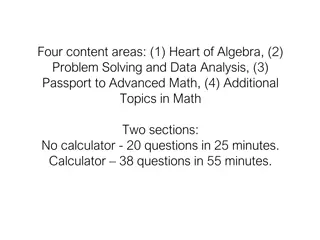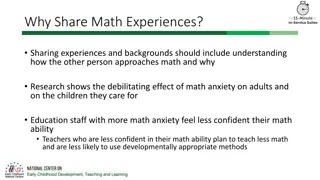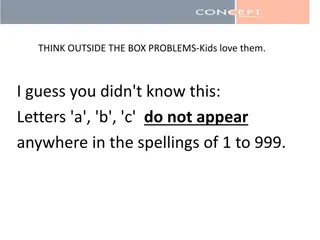
Brain Connectivity Analysis in Type-II Diabetes Patients Revealed
Explore how brain connectivity patterns differ in Type-II diabetes patients, potentially aiding in distinguishing and predicting clinical symptoms. Utilizing data collected from MRI scans, this study investigates the relationship between disrupted brain connectivity and the risk of developing Alzheimer's disease in diabetic individuals.
Uploaded on | 0 Views
Download Presentation

Please find below an Image/Link to download the presentation.
The content on the website is provided AS IS for your information and personal use only. It may not be sold, licensed, or shared on other websites without obtaining consent from the author. If you encounter any issues during the download, it is possible that the publisher has removed the file from their server.
You are allowed to download the files provided on this website for personal or commercial use, subject to the condition that they are used lawfully. All files are the property of their respective owners.
The content on the website is provided AS IS for your information and personal use only. It may not be sold, licensed, or shared on other websites without obtaining consent from the author.
E N D
Presentation Transcript
Detect the disrupted brain connectivity in type-II diabetes patients MATH 5470 project WEI, Yue & XIE, Weiyan 1
Background Background Type-II diabetes and Alzheimer's disease It is confirmed that Type-II diabetes patient has higher risk of getting Alzheimer's disease Research revealed that the brain connectivity strength changed in Type-II diabetes patients even before they showed impairment in cognition MRI can collect the brain connectivity strength between each pair of brain regions Following figure showed the brain connectivity strength changes in Type-II diabetes patient (from data collected by No.1 Affiliated Hospital of GUCM, unpublished work) Permutation test with FWA correction: Red patient > control, p<0.025 Blue patient < control, p<0.025 2
Scientific questions Scientific questions 1. Can we use brain connectivity features to distinguish type-II diabetes and healthy people in control group? 2. Can we use brain connectivity features to predict clinical symptoms of type-II diabetes? 3. With so many connectivity features, which are the top 5/10 features that contributed most to the classification & symptom prediction of type-II diabetes? 3
Data structure (X) Brain connectivity feature (for each subject): Pairwise connection between AAL90 brain regions Weighted by Fractional anisotropy (FA): f1=90*90=8100 Weighted by fiber number (FN): f2=90*90=8100 Brain nodal feature(for each subject): ROI surface size: f3=90 ROI voxel size:f4=90 *This is a dataset collected by No.1 Affiliated Hospital of GUCM which co-worked with WEI Yue, we have one under reviewing paper on this dataset, not published yet. 4
Data structure (Y) Subject groups (G=2): Patient (N1=47) Control (N2=47) Clinical symptoms (continuous data): duration FBG BMI HbA1c *This is a dataset collected by No.1 Affiliated Hospital of GUCM which co-worked with WEI Yue, we have one under reviewing paper on this dataset, not published yet. 5
Methods Methods Dimension Reduction: Principal Component Analysis (PCA) Canonical Correlation Analysis (CCA) Building Classification and Prediction Models: Logical Regression (with Subset Selection: Forward/Backward Stagewise) Decision Tree Adaboost Random Forest Support Vector Machine A small neural network 6
Methods Methods Explaining the ''black-box'' methods: We expect that the methods with higher flexibility, like SVM and Neural Network, may give better classification performance. The issue with these methods is that they are black-box and not self-explainable. As our final goal is not only to train a model with good classification performance, we are also interested in what features are important to the classification. Therefore, some Explainable AI (XAI) methods will be used to explore the feature importance in the black-box methods. XAI methods planned to use: Local Interpretable Model-Agnostic Explanations (LIME); SHapley Additive exPlanations (SHAP). 7
Plan Plan Stage 1 Data Visualization and Some Basic Data Explorations Stage 2 Dimension Reduction Stage 3 Model Buildings and Comparisons Stage 4 Understanding the Models Stage 5 Report and Presentation 8






















